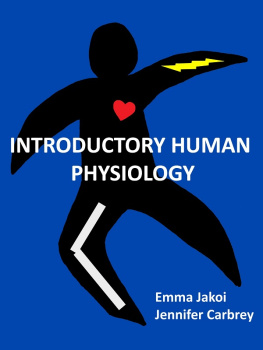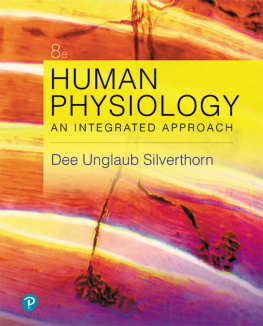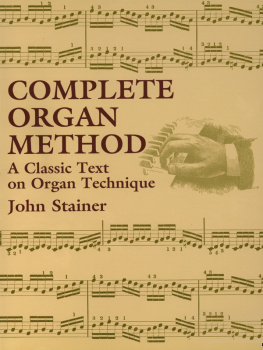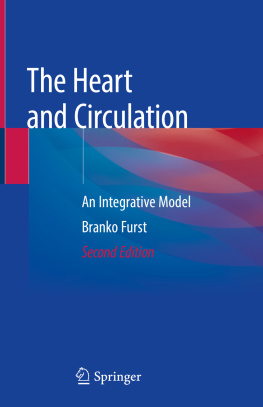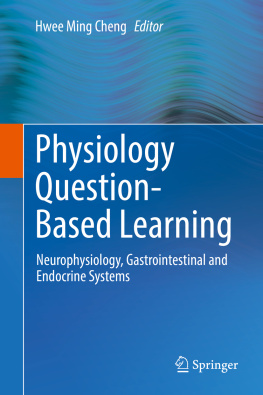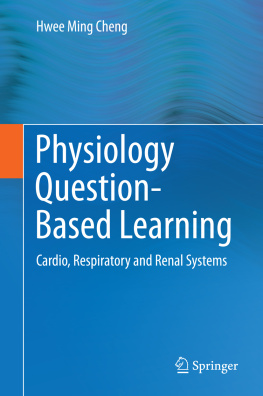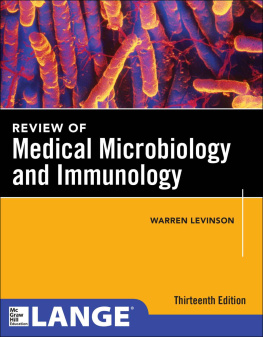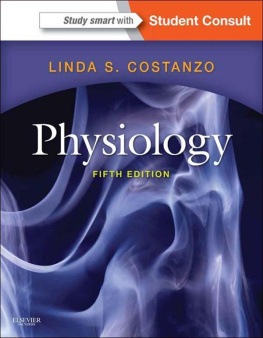CHAPTER 8: THE GASTROINTESTINAL SYSTEM
Emma Jakoi, Ph. D.
8.1 GENERAL STRUCTURE & FUNCTION
LEARNING OBJECTIVES
- Describe the functional anatomy and role of the digestive system.
- Describe the production of gastric acid in the stomach.
- Describe the time course of acid secretion in the fed and fasted states .
OVERVIEW
The digestive system provides nutrients, water, and electrolytes to the cells of the body from the external environment. Food enters the oral cavity and is propelled by muscular contractions through the gastrointestinal (GI) tract moving towards the anus. At various points along the GI tract, acid, digestive enzymes, and buffers are added to facilitate the breakdown of complex foods (such as steak and rice) into simple molecules (such as amino acids, glucose, and fatty acids). These products are then absorbed into the body and delivered to the liver. The various secretions of the GI tract (enzymes, mucus, and water) sum to about 7 liters. This fluid is reabsorbed to prevent dehydration. Unabsorbed nutrients and waste products are eliminated from the body as feces (100 mL 500mL per day).
GENERAL ANATOMY
The digestive system includes the gastrointestinal t ract and accessory organs ( Figure ).
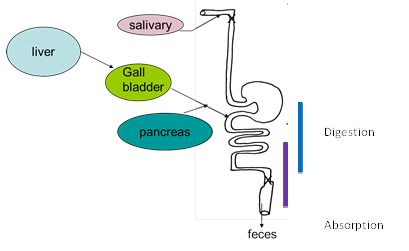
Figure . Functional regions of the gastrointestinal tract and associated organs.
The outside wall of the gastrointestinal tract has two layers of smooth muscle which are oriented pe rpendicular to each other ( Figure ). Constriction of the innermost layer of muscle changes the diameter of the tube. Constriction of the outermost layer of muscle shortens the tube .
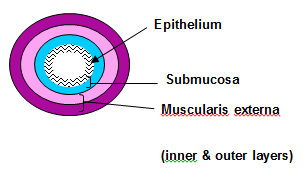
Figure . Tissue layers of the gastrointestinal tract.
The lumen of the gastrointestinal tract is lined by a layer of cells (called epithelium) which differs in structure along the tract. At the two ends, esophagus and anus, there is a wear and tear non-secretory, non-absorptive epithelium ( Figure ). The stomach has a secretory epithelium and the small intestines, absorptive epithelium.
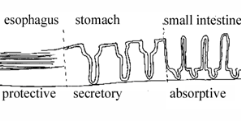
Figure . Changes in the gastrointestinal tract epithelium reflect function.
There are four accessory organs (salivary glands, liver, p ancreas and gall bladder) ( Figure ). Secretions from the salivary gland are added to the oral cavity. Those from the liver are stored within the gall bladder and then released along with those from the pancreas into the duodenum (first portion of the small intestine).
INGESTION & FRAGMENTATION
Ingestion and fragmentation (chewing) of food occur within the oral cavity. Chewing reduces the size of the food particle and increases its surface area to facilitate attack by digestive enzymes. Chewing and later swallowing are aided by the secretion of saliva from three salivary glands . Enzymes in saliva initiate the breakdown of complex carbohydrates such as bread and cereals. The bolus of shredded food is then conveyed to the esophagus by the actions of the tongue during swallowing. Transit through the esophagus to the stomach is rapid.
ACID SECRETION & DIGESTION
The stomach can hold ~2 liters of food and fluid. It is divided into four regions ( Figure ): cardiac, fundic, antrum, and pyloric. The epithelium in all four regions secretes a protective barrier of mucus, a carbohydrate rich material that coats the surface of the lumen. The cells of the fundic region produce hydrochloric acid (HCl) into the lumen of the stomach. The cells of the antrum regulate the production of acid.
Digestion of dietary protein starts in the fundic region of the stomach. Here the epithelium lining the lumen contains 3 cell types: mucous secreting cells, chief cells and parietal cells. Their specific functions are as follows:
MUCOUS CELLS secrete mucus that protects the epithelium from acid.
CHIEF CELLS secrete pepsinogen, an inactive enzyme, which is converted to an active enzyme called pepsin by acid in the lumen of the stomach.
PARIETAL CELLS secrete intrinsic factor and hydrochloric acid (HCl). Intrinsic factor is a carrier required for the absorption of vitamin B12 by the ileum (distal region of the small intestine). Vitamin B12 is necessary for the formation of red blood cells. In the absence of intrinsic factor, vitamin B12 absorption is insufficient resulting in pernicious anemia. HCl is a strong acid which lowers the stomach contents to a pH of 2.0- 5.0.
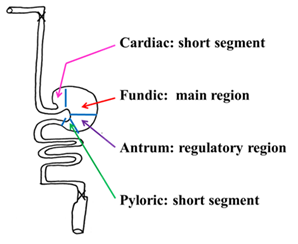
Figure . Functional regions of the stomach.
SECRETION OF HYDROCHLORIC ACID BY PARIETAL CELLS
The production of hydrochloric acid (HCl) by the parietal cells requires the activity of the enzyme, carbonic anhydrase . In the presence of carbonic anhydrase, CO2 and H2O are converted to HCO3- and H+.

As shown in Figure , the newly generated proton (H+) is transported into the lumen of the stomach via the H+- K+ ATPase (called the proton pump) . Concurrently, HCO3- exits from the basal surface (blood side) of the parietal cell via the HCO3- - Cl- antiporter .
The chloride ion (Cl-) needed to form HCl, enters the parietal cell from the blood via the HCO3- - Cl- antiporter and exits at the luminal side by the Cl- channel . Once within the lumen of the stomach, Cl- combines with H+ to form HCl.
The luminal K+ that is needed to maintain the activity of the proton pump (H+-K+ ATPase) , enters the parietal cells from the stomach lumen by the H+-K+ ATPase and is then recycled back into the lumen of the stomach by the K+ channel ( Figure ).
Why is acid needed? The acidic pH in the stomach lumen is needed to convert pepsinogen (inactive pepsin) to pepsin (active enzyme) and to provide an optimal pH for pepsin action. Within the lumen of the stomach, muscle contractions mix the food particles with the HCl and the enzyme pepsin producing a semi-digested liquid called chyme .
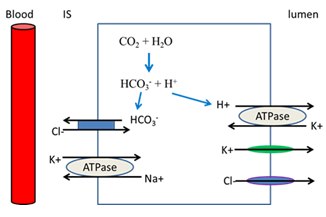
Figure . Mechanism of HCl secretion.
Exposure of the food bolus to HCl starts the digestion of proteins. In addition, the HCl kills any bacteria that enter with the food.
With entry of food into the lumen of the stomach, acid secretion increases and reaches a peak o utput (PAO) by 90 minutes ( Figure ). Acid production subsequently falls as food leaves the stomach lumen to enter the small intestine.

Figure . Secretion of gastric acid during fed states. Why does the pH initially rise then fall by 2 hours after a meal?
It takes ~ 4 hours to empty the stomach after a meal because only a few milliliters of acidic chyme exit to enter the proximal small intestine (duodenum) at any time.
KEY CONCEPTS
- The digestive system provides nutrients, water and solutes to the cells of the body from the external environment.

